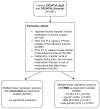Thyroid Hormones Are Not Associated with Plasma Osteocalcin Levels in Adult Population with Normal Thyroid Function
- PMID: 36005591
- PMCID: PMC9412351
- DOI: 10.3390/metabo12080719
Thyroid Hormones Are Not Associated with Plasma Osteocalcin Levels in Adult Population with Normal Thyroid Function
Abstract
Thyroid hormones (THs) play an indispensable role in skeletal development and bone remodeling. Some studies have reported associations of THs with serum osteocalcin (OC) levels, but the results are quite inconsistent and the molecular mechanism of their simultaneous or interdependent activity on bone is almost unknown. Therefore, the aim of this study was to determine the possible associations of plasma THs with plasma OC levels and the possible mediating effect of OC on the relationship between THs and bone mineral density (BMD). For this purpose, out of the initial 1981 participants, we selected healthy euthyroid participants controlled for available confounding factors that can affect thyroid function and bone metabolism (N = 694). Given our results, we could not confirm any associations of THs with plasma OC levels nor the mediating effect of OC on the relationship between THs and BMD in euthyroid population. In the group of women controlled for menopause status (N = 396), we found a significant negative association of body mass index (BMI) with OC levels (β = −0.14, p = 0.03). We also found a negative association of free triiodothyronine (fT3) (β = −0.01, p = 0.02) and age (β = −0.003, p < 0.001) with BMD, and a positive association of BMI (β = 0.004, p < 0.001) and male gender (β = 0.1, p < 0.001) with BMD. In addition, we found significantly higher plasma OC levels and lower values of BMD in postmenopausal euthyroid women compared with premenopausal euthyroid women. In our opinion, the results of previous studies suggesting an association between circulating THs and serum OC levels may be influenced by an inconsistent selection of participants and the influence of confounding factors.
Keywords: body mass index; bone mineral density; osteocalcin; thyroid hormones; thyroid-stimulating hormone.
Conflict of interest statement
The authors declare no conflict of interest.
Figures



References
-
- Tsourdi E., Wallaschofski H., Rauner M., Nauck M., Pietzner M., Rettig R., Ittermann T., Völzke H., Völker U., Hofbauer L.C., et al. Thyrotropin serum levels are differentially associated with biochemical markers of bone turnover and stiffness in women and men: Results from the SHIP cohorts. Osteoporos. Int. 2015;27:719–727. doi: 10.1007/s00198-015-3276-x. - DOI - PubMed
Grants and funding
LinkOut - more resources
Full Text Sources

